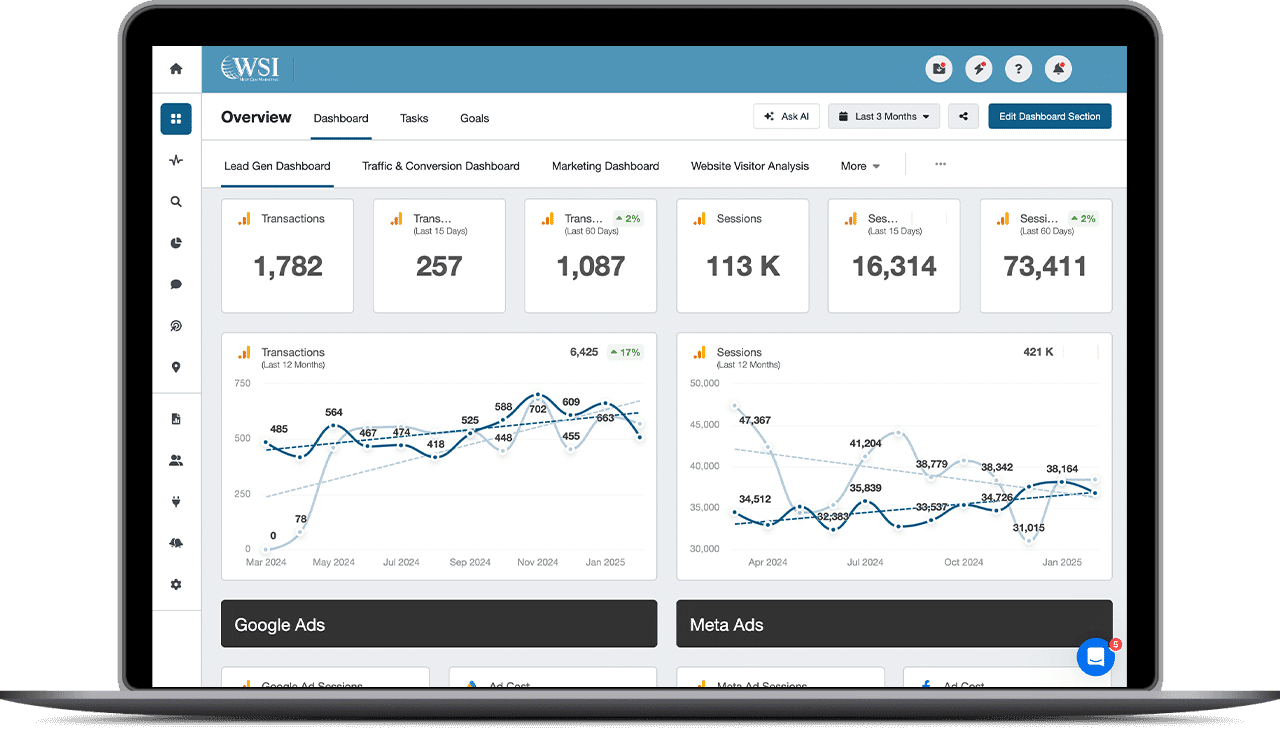MARKETING STRATEGY
Customized Marketing Strategy to Drive Growth
Unlock your potential with our results-driven, AI-enabled marketing strategies.
Running a business without a well-thought-through strategy is like setting sail in stormy seas without a compass. At WSI Next Gen Marketing, we believe in building on the foundation of a well-orchestrated marketing strategy to guide your company’s journey through the tumultuous markets. At its core, a marketing strategy is a coherent plan that aligns all marketing efforts with your business goals.
Why Marketing Strategy Matters
— BREAK IT DOWN
Key Components of a Marketing Strategy
A marketing strategy stands as the cornerstone of a business’ attempt to communicate effectively with its audience and secure a place in the market. It acts as a compass guiding all marketing efforts, ensuring they are targeted and coherent. Without one, resources could be consumed without the intended impact, and the messages to potential customers could become diluted and ineffective. A well-devised strategy enables a business to connect with its target audience, building relationships and establishing trust which are key to long-term success. It provides a structured approach to track performance and ROI, enabling businesses to achieve their specific goals.
Setting clear marketing goals
LEARN MORE
Establishing detailed, achievable marketing goals is a core principle of a successful marketing strategy. These goals should be quantifiable, allowing for measurement and adjustment over time, thereby adhering to the SMART (Specific, Measurable, Achievable, Relevant, and Time-Bound) criteria. Setting clear goals not only directs focus and resources but also motivates the marketing team by providing clear directives and benchmarks for success. Examples of marketing goals might include increasing website traffic by 15% within six months or growing the subscriber base for an email marketing campaign by 10,000 users within a year.
Aligning the marketing strategy with the business goals is crucial for creating synergy within an organization. For a strategy to be effective, it must not only seek to increase visibility or sales in the short term but also support the long-term vision and objectives of the company. This strategic alignment means that marketing initiatives reinforce business goals, whether it be market expansion, brand recognition, or revenue targets. When there is coherence between the strategy and the business goals, every marketing effort propels the organization forward, creating momentum towards achieving larger corporate milestones.
Gaining a competitive advantage
LEARN MORE
Identifying target audience and market segments
LEARN MORE
To stand out in a crowded market, a company must leverage its unique selling proposition (USP) through its marketing strategy to gain a competitive advantage. By identifying and promoting what makes the business different and better than competitors, it can attract and retain customers more efficiently. A successful marketing strategy encompasses not just advertising and promotions but also includes creating a consistent brand message, offering products and services that not only meet but exceed customer requirements and expectations. Gaining competitive advantage is about taking the opportunity to differentiate and position the business as the preferred choice for its target customers.
Understanding the customer journey along the sales funnel
LEARN MORE
Selecting the appropriate marketing channels
LEARN MORE
Developing a comprehensive marketing plan
LEARN MORE
— HOW IT WORKS
Our Marketing Strategy Process
01.
Discovery & Analysis
02.
Strategy Formulation
Implementation & Optimization
— WHERE DOES IT FIT?
Digital Marketing as Part of an Overall Marketing Plan
Running an effective marketing strategy must embrace the expansive reach and targeting capabilities of online platforms. A digital marketing strategy is a comprehensive plan that leverages digital channels such as search engines, social media, email, and websites to connect with current and prospective customers. The success of digital marketing depends on its integration within the broader marketing campaigns and its alignment with the company’s overarching business objectives. It requires a deep understanding of the target market, setting measurable goals, analyzing competitors, and selecting the right digital tools to engage and convert your target audience. Establishing KPIs to measure the performance of digital channels and campaigns is critical to optimizing the digital marketing strategy over time.
Attracting leads using search engine optimization and digital advertising
Search Engine Optimization (SEO) and digital advertising are pivotal for generating leads for a business.
SEO is a long-term lead generation method, focusing on improving a website’s organic search rankings and visibility on search engines over time. By optimizing site content, structure, and on-page elements, businesses can attract a steady flow of inbound leads via their website.
On the other hand, digital advertising aims to produce immediate visibility and lead generation. Each advertising method below plays a unique role across the different stages of the sales funnel:
- Google advertising is keyword-focused and intent-based, ideal for capturing leads actively searching for related products or services.
- Social media advertising leverages user data to target specific demographics, interests, and behaviors.
- Programmatic advertising automates the buying of ads and targets audiences more specifically through a wide variety of advertising channels.
Creating compelling content that converts
The heart of a successful digital marketing strategy lies in the content that educates, engages, and entices the audience to act – content is king, as the saying goes. A well thought through and executed content strategy can transform passive readers into active participants by leveraging lead magnets such as eBooks, webinars, and infographics. These resources provide value to potential customers, encouraging them to exchange their contact information for the content.
Additionally, content plays a crucial role in building E-E-A-T (Experience, Expertise, Authoritativeness, Trustworthiness) with Google, promoting higher search engine rankings and driving organic traffic. Compelling content, therefore, is not just a vehicle for information; it is a strategic tool that empowers businesses to connect with their audience, nurture leads, and drive conversions.
Utilizing social media for marketing
Social media stands as a powerful pillar in any digital marketing strategy, excelling as a trust builder among consumers. Social media channels like Facebook, X (formerly Twitter), Instagram, and LinkedIn offer businesses the opportunity to establish a more personal and authentic connection with their audience. Engaging directly with followers, sharing content that reflects brand values and culture, and participating in social conversations endear a brand to its current and potential customers. A well-orchestrated social media strategy not only helps to grow a community around a brand but also serves as a stage for customer testimonials and word-of-mouth promotion, which can significantly influence buying decisions. Leveraging influencer marketing can further amplify the reach and impact of social media campaigns. Collaborating with influencers who have a sizable following and align with the brand’s values can help businesses tap into new audiences and build trust through authentic recommendations and endorsements.
Establishing a strong email marketing strategy
Email marketing endures as a cornerstone in digital communication, offering businesses a direct and personal channel to their audience; email lists are marketing assets that the company owns. It allows for segmented, targeted communication that can be personalized to meet the interests of different audience groups. A well-crafted email marketing strategy strengthens the relationship with prospects and customers, keeping them engaged and informed about new products, services, and company news. Whether through newsletters, promotional campaigns or loyalty programs, emails drive customer retention and value by delivering relevant content that encourages ongoing engagement with the brand.

— HOW DO YOU KNOW IF IT’S WORKING?
Defining key performance indicators (KPIs)
KPIs are quantifiable measures that reflect the critical success factors of a marketing strategy. They vary depending on the organization’s specific objectives but are essential in tracking progress against the business’s overall goals.
Start with SMART goals to drive strategy
When defining KPIs, it’s important to ensure they are SMART: Specific, Measurable, Achievable, Relevant, and Time-bound. Common marketing KPIs might include conversion rates, website traffic, lead generation numbers, and overall sales revenue. For instance, in a digital marketing strategy, the following KPIs could be prioritized:
- Conversion Rate: The percentage of visitors who take a desired action.
- Customer Acquisition Cost (CAC): The cost incurred to acquire a new customer.
- Return on Investment (ROI): The financial return generated from a marketing campaign.
- Customer Lifetime Value (CLV): The total revenue a business can expect from a single customer account.
Analyzing performance metrics and data
After identifying the KPIs, the next step is delving into performance metrics to get a granular view of the strategy’s outcome. This includes data analysis to track trends, identify patterns, and dissect the underpinnings of success or failure. Marketers use various tools and platforms, like Google Analytics or CRM software, to capture this data. Key data points could involve website visitor engagement, page views, social media engagement rates, or email click-through rates. By continuously analyzing these metrics, marketers can pivot or reinforce their strategies, ensuring alignment with the marketing objectives.
Tracking customer engagement and loyalty
Customer engagement revolves around the interactions between the brand and its customers across the various platforms — the more engaged the customers, the higher their loyalty tends to be. Metrics like net promoter scores (NPS), repeat purchase rates, or engagement rates on social media offer insights into how emotionally invested customers are with the brand. Tracking these indicators requires active listening and monitoring systems, such as social media analytics tools or customer feedback surveys. Moreover, loyalty programs and customer satisfaction scores help gauge the level of trust and dependability customers place in a brand.
By meticulously measuring and analyzing these different facets, a comprehensive view of the marketing strategy’s effectiveness comes into focus, laying the groundwork for informed decision-making and strategical adjustments.
— GET ALIGNED
Creating a Marketing Strategy for Different Business Objectives
Creating a successful marketing strategy hinge on aligning it with the company’s business objectives. Each goal requires a tailored approach that considers the unique aspects of the target market, the competitive landscape, and available resources. Below is a breakdown of marketing strategies aligned with two specific business goals:
Generating brand awareness and visibility
To boost brand awareness and visibility, a company must reach a broad audience and create a memorable presence. Key tactics include:
Social Media Marketing: Build a strong social media presence to engage with users on platforms where they spend the most time.
Content Marketing: Develop valuable and shareable content to attract and engage potential customers.
SEO Strategy: Enhance online visibility through search engine optimization that improves organic search rankings.
Advertising Strategy: Invest in online and offline advertising to increase brand recall.
Increasing customer acquisition and retention
Attracting new customers and keeping them requires a combination of marketing efforts that convey value and foster loyalty:
Persona Development: Create detailed customer personas to tailor messaging that resonates with the potential customers.
Targeted Campaigns: Utilize marketing channels to run targeted campaigns aimed at ideal customers.
Email Marketing Strategy: Engage customers with personalized email campaigns that nurture leads and retain existing customers.
Loyalty Programs: Implement loyalty programs that reward repeat, loyal customers, enhancing retention.
Ready to Elevate Your Marketing? Let's Strategize.
Let us guide you through each step of creating and executing a marketing strategy that makes a difference. Contact us to begin your journey to greater market impact.
— HEAR FROM OTHERS







